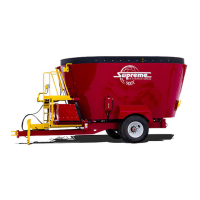Mechanical Stationary
Operator’s Manual
© 05/2020 300-0804
21
NOTICE
Do not load any long stem hay at or near the end of the
loading sequence. This hay will have a tendency to “float”
and may not completely work into the ration.
OPERATION
Adjusting Mix
If in the nal mixed sample, the forage is cut too short:
• Decrease auger RPM (VFD only)
• Reduce the initial break-up or cutting time
•
breaks apart the baled hay (particularly round bales) and aids in the mixing process
If in the nal mixed sample, the forage is too long:
• Increase auger RPM (VFD only)
• Move one or both restrictor plates into position #2
• Add a knife assembly to the augers
•
If the forage bale is slow to come apart or the core will not come apart:
• Add an additional knife to the top of the auger, one notch below the top knife
If bale is coming apart, but it is slow to cut into smaller lengths:
• Add an additional knife to the bottom of the auger, working up one notch from the last knife
If ration is being cut faster than it is mixed:
• Try removing knife #4 and/or #3 to even out the process
When processing and mixing roughages there may be some spillage over the side of the tub. To remedy this problem:
• Check and see if the restrictor plates are in position #2. If so, set either one to position #1.
• If problem still occurs, set second restrictor plates to position #1 (if equipped with a second on the unit)
If spillage still occurs: Reduce the auger speed until roughage is coarse cut, then resume normal auger speed.
NOTICE
It is important to remember the following guidelines
when adding or removing knives.
Too many knives may impede the cutting/mixing
process. Any more than seven knives may prevent
the feed from falling to the bottom of the tub and
subsequently slow down the cutting/mixing process. Too
few knives or removing knives will slow down the cutting
process.
34 provides some
examples of problems that can arise during the cutting/
mixing process and troubleshooting tips on how to correct
those problems.

